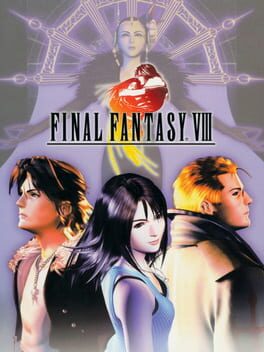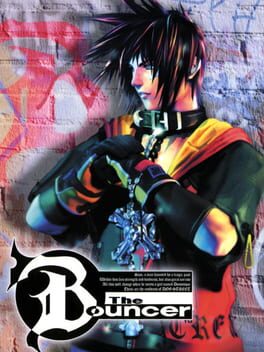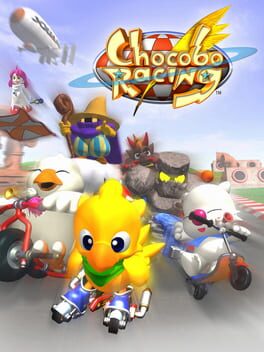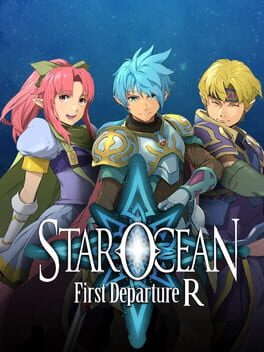Mostly PlayStation and Nintendo, I play a plethora of genres, my favorite being JRPGs. Favorite series include Final Fantasy, Metal Gear Solid, MOTHER, and Persona.
Badges

Loved
Gained 100+ total review likes

GOTY '23
Participated in the 2023 Game of the Year Event

Pinged
Mentioned by another user

GOTY '22
Participated in the 2022 Game of the Year Event

Gone Gold
Received 5+ likes on a review while featured on the front page

Popular
Gained 15+ followers

Donor
Liked 50+ reviews / lists

Organized
Created a list folder with 5+ lists

Gamer
Played 250+ games

Shreked
Found the secret ogre page

Roadtrip
Voted for at least 3 features on the roadmap

Well Written
Gained 10+ likes on a single review

Full-Time
Journaled games once a day for a month straight

On Schedule
Journaled games once a day for a week straight

Best Friends
Become mutual friends with at least 3 others

Liked
Gained 10+ total review likes

Noticed
Gained 3+ followers

3 Years of Service
Being part of the Backloggd community for 3 years

GOTY '21
Participated in the 2021 Game of the Year Event

N00b
Played 100+ games
Favorite Games
336
Total Games Played
014
Played in 2024
147
Games Backloggd
Recently Played See More
Recently Reviewed See More
My first experience with Klonoa was just about 2 months ago, right at the end of January. I knew next to nothing about this little guy and the extremely niche series that he hailed from, but what sparked my interest in these games was the profound and impactful impression that they left on people when I stumbled across its review page on this platform. Luckily for me when I was checking out my local game store, a copy of the Klonoa Phantasy Reverie series was sitting on the shelf and I instantly purchased it.
What appears as a simple, colorful mascot platformer at first glance, turns out to be so much more. Halfway through the game, Klonoa experiences pure rage and sadness in a turn of events that completely threw me off guard. It was this moment that made me realize what everyone had been talking about and why this game was so special. Door to Phantomile isn’t just a cheerful game with a cute mascot catered to children, it hides a much darker and deeper meaning beneath its shallow facade of innocence. I continued onward and found myself becoming attached to Klonoa and Huepow, two characters that I had literally just been introduced to only a couple of hours prior, and in no time I had defeated the final boss. I felt satisfied and glad to have witnessed Klonoa and Huepow’s teamwork and friendship triumph over Ghadius’ vile intentions to enshroud the world in an endless nightmare. Everything was wrapping up happily and was very wholesome… until the final scene of the game played out.
Even after experiencing Door to Phantomile twice (initial Phantasy Reverie playthrough, and a replay of the original PS1 version), I still find it hard to put into words how the ending makes me feel. One thing is for certain, it’s genuinely one of the saddest video game endings I’ve ever experienced.
No punches are pulled when the truth of Klonoa’s existence comes out from who he assumes is his long time best friend. A revelation so shocking and yet so heartbreaking all thanks to the masterful use of music, phantomilian voices/dialogue, and of course the expressive sprite work. The conclusion of Door to Phantomile stunned me, and I couldn’t shake the emotions I had towards its ending for days… and weeks… and at this point a month had passed, a time frame in which I usually would have moved on to the next game in my backlog and forgotten about the previous games I had played.
But Klonoa isn’t just the “usual” game. I was constantly listening to the soundtrack, reading how it impacted other people’s lives, and thinking about it all the time. I would get lost in thought over this game to the point that I would ponder my own life, dreams, and purpose. It sounds silly, but I had to experience this game again. So fast forward two months from my initial completion of Door to Phantomile’s Phantasy Reverie remaster, I bit the bullet and secured myself a copy of the original game for the PS1.
The original version of Door to Phantomile is undeniably the best way to play the game. Graphically, it is absolutely beautiful, delivering a presentation of vibrant 3D environments, with characters and enemies appearing as 2D prerendered sprites. This style works so well with the game and completely outclasses the all 3D look that the remaster has. Not only does the gameplay look better, but the FMV cutscenes throughout the game are gorgeous and show so much more emotion and drama than what is shown in the remaster.
The childlike whimsy and dreamy aesthetic of Door to Phantomile oozes with so much charm, I truly can’t get enough. The theme of dreams and where they go once you wake up is delivered even better when you realize that as the game goes on, the environments and music begin to change, reflecting the atmosphere and tension of what is occurring during Klonoa and Huepow’s adventure. The opening stage throws the player right into a breezy and uplifting windmill village stage, the accompanying music consisting of woodwinds, acoustics, and stringed instruments. But during the last stages of the game, the music has completely transformed from natural melodies to something far more artificial, electronic, and otherworldly.
I could talk about how absolutely brilliant the soundtrack is for this game, but I want to move on to the gameplay aspects. Klonoa is a 2.5D platformer that, while mostly linear, does have branching paths and optional areas to explore in every level. The main gameplay gimmick is that Klonoa can use his wind ring to grab enemies a short distance from him, inflate them like a ball, and use them as a projectile or jump off of them for a second mid-air jump. This mechanic paired with the 3D environments leads to some pretty creative puzzles, such as throwing an enemy into the foreground or background to obtain a collectible, or inflate and jump off of multiple mid-air enemies to gain a ton of height whether it be to reach a high ledge, or to avoid falling into an endless abyss or pit of lava. For a game that only uses four buttons (left, right, jump, and shoot), Klonoa somehow manages to only get more interesting and ramp up the difficulty with super fun level designs and a large variety of enemy types. While most of the enemies are mindless drones that can easily be inflated, some of them can be very annoying to deal with in those late game levels.
Where the gameplay of Klonoa really shines however is in its boss fights. Every single one progressively gets more challenging, the music absolutely slaps, and they feel completely unique despite the objective always being to grab and throw enemies at the boss’s weak point. The late game bosses in particular can be pretty difficult and they have multiple phases in which different strategies need to be utilized. Overall the difficulty curve is pretty steady and goes from being a super easy platformer to a test of mastery and precision of the game’s mechanics.
What makes Klonoa standout amongst its competitors and the droves of other mascot platformers however, is its story. Door to Phantomile tells a tale deeply personal to so many people, including myself. I never imagined in my wildest dreams that this would be the game that touched my heart and reminded me that it’s okay to cry, even when it’s something as simple as a videogame about a little rabbit cat creature jumping around inflating his foes. For a 3-4 hour long experience, I was fully immersed into this world and its characters to the same degree that I would be with a 40+ hour long videogame. Door to Phantomile expertly combines music, dialogue, and sprite work to express emotion in a way that few games can even hope to achieve, and I genuinely consider this game to be a masterpiece. It tackles the idea of dreams in a manner that is freakishly relatable to experiences I have had with them, such as the perfect reality or absolute bliss, only for it all to be stripped away because you’re waking up. It’s a concept so beautiful and yet so harsh, realizing that when you do wake up, you can barely even remember what it was you dreamt. Imagine the friends you made, the memories you shared, and your life as you knew it all being a fabricated lie. It is with this dread that Klonoa’s tale comes to a close.
“It's strange... Sometimes I can't remember my dreams, though I'm sure I saw them. Where do these dreams go? But I remember this one dream, as clearly as if it were reflected in a mirror...”
For starters, this remaster of the original Star Ocean (Super Famicom) does wonders to the presentation of the game adding a sort of PS1-esque visual sense reminiscent of Star Ocean the Second Story. The pixelated character sprites set against prerendered backgrounds was neat, but the real shining factor was how the combat looked aka my favorite aspect of the game.
The battle system is fast paced with easy controls and a fun ability to choose a single character to control manually while the other three party members could have tactics set, altering the way the AI controlled their abilities and movement. It’s sort of a precursor to how FFVIIR handles its battle system and overall I looked forward to the battles… sometimes. Unfortunately the random encounter rate is astronomically high and gets extremely annoying while trying to traverse dungeons, so there’s that.
The skill point system is pretty innovative, but can also curse you if you don’t upgrade certain skills wisely. It’s easy to abuse how this system works by upgrading, for example, your Determination skill for each character, that way every single other skill they can learn requires less skill points to obtain. I restarted my first save because I blew all of my skill points up to level 10 or so unknown to the fact that Determination existed, so that was really fun…
Later on in the game when you get to the Silvalant Continent, the difficulty spike in random encounter enemies is INSANE. I was breezing my way through 15-20ish hours of gameplay and the instant I set foot outside I was getting demolished by the enemies. Through hours of level grinding and careful skill point distribution, I managed to get ahold of my party and continued on with the game, but that brutal jump in difficulty seriously made me question finishing the game or not.
Just before the end game stretch to the Demon World, I spent a whole day delving into Star Ocean’s specialty and super specialty system, which I slept on heavily throughout most of my playthrough. This is where I started to enjoy the overall experience more, and where the fun really began. Level up your main party’s skills so that they learn the abilities to play and compose music so you get Orchestra. Then make sure you level up more skills so your characters are proficient in customizing weapons and crafting new armor/accessories. With this you can have Orchestra play in the background to greatly increase the success rate of performing your specialties and completely break the game by obtaining ridiculously overpowered pieces of equipment.
With that, the remainder of Star Ocean FDR was a walk in the park and the final bosses all perished to me in mere seconds :)
If you couldn’t already tell, the gameplay systems and their implementation in battle is by far the best this game has to offer. Story wise it’s extraordinarily bland. I liked all the characters the game had and the ability to recruit certain ones while being locked out of others adds to the replayability. The Private Action scenes too were enjoyable and gave me lots of laughs with the interactions between party members, but main story wise it’s nothing to write home about.
At the end of it all, I’m still super glad I gave this title a shot. I tackled the learning curve of Star Ocean’s ingenuity and gained not just understanding for the importance of its series defining gameplay systems, but also a thirst to explore what other titles come after First Departure.









